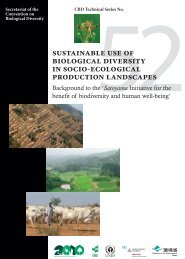INDIAN SCIENCE CONGRESS - India Environment Portal
INDIAN SCIENCE CONGRESS - India Environment Portal
INDIAN SCIENCE CONGRESS - India Environment Portal
You also want an ePaper? Increase the reach of your titles
YUMPU automatically turns print PDFs into web optimized ePapers that Google loves.
Section XIV : Plant Sciences 17<br />
Baspa valley in Kinnaur district of Himachal Pradesh has remained one of the<br />
floristically under-explored valleys in the north-west Himalayan region due to its<br />
remote location and limited communication facilities. The valley with an area of<br />
about 400 km 2 and having an altitudinal range from 1750 amsl at Karchum to 4750<br />
amsl at the Rupin pass was surveyed extensively for five years do document the<br />
plant diversity. The study area was stratified into catchment-wise and altitude-wise<br />
zones for uniform repeated surveys, for systematic documentation of the flora,<br />
using random sampling method. The field observations were supported with<br />
herbarium collections and voucher specimens kept in established herbaria including<br />
the DD and the BSI Northern Circle Herbaria at Dehradun. The authenticated<br />
herbarium sheets have been deposited in and accessed to the HFRI Herbarium,<br />
Shimla.<br />
The study resulted in enumeration of 957 taxa belonging to 475 genera<br />
spread over 122 families of Gymnosperms and Angiosperms. While this list<br />
includes 48 cultigens and 35 exotics/ ornamentals species, it is limited to the<br />
extent that it does not include wild grasses and sedges belonging to families<br />
Poaceae and Cyperaceae. An analysis of this list shows that family Asteraceae<br />
with 132 taxa belonging to 61 genera is the most dominant family of flowering<br />
plants in the valley, whereas as per Hooker’s Flora of British <strong>India</strong> it is the<br />
family Orchidaceae that contains the highest number of plants, with Asteraceae,<br />
placed at the seventh position. Moreover, the number of dicots far exceeds<br />
the monocots and gymnosperms in this valley with a proportion in respect of<br />
species and genera belonging to dicots and monocots being 91 :09 and 90 :10<br />
respectively. The analysis of the growth forms of the species further reveals<br />
that the flora of Baspa valley is predominantly herbaceous with herbs forming<br />
73.3% (702 taxa) of the total flora, followed by 19% shrubs (181 taxa) and<br />
7.7% trees (74 taxa).<br />
The study is a comprehensive enumeration of flora of the valley, for the first<br />
time. It provides base line information to monitor the impacts of various ongoing and<br />
planned developmental activities, including setting up of hydroelectric projects,<br />
development of eco-tourism and establishment of orchards, etc. in the valley. The<br />
study provides necessary inputs for better management and utilization of the land<br />
and plant resources of this pristine valley.
















